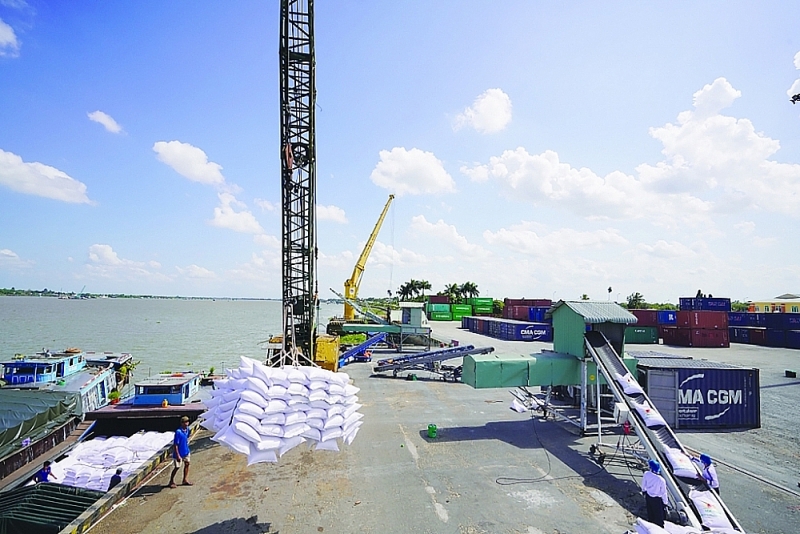Rice production shifts positively following market signs
Following the shifting demands of rice importing countries for high-quality products, Vietnam's rice production is also shifting strongly to high-grade rice varieties and achieving many successes.
 |
|
Transporting rice from barge to export container at Tan Cang Sa Dec. Photo: TL |
Towards high-quality rice
Speaking at the seminar "Opening up the flow of Vietnamese rice" held on June 22, Mr. Pham Quang Dieu, Director of Vietnam Market Analysis and Forecast Joint Stock Company (Agromonitor) pointed out the fact that the Philippines, Vietnam's largest rice market, changed from importing medium-quality rice to importing high-quality rice. This has created a huge boost for Vietnam's rice industry. Accordingly, rice production has shifted from low-grade rice to high-quality rice.
For example, in the Winter-Spring crop 2018-2019, the production area of IR 50404 rice (medium quality products) accounted for about 21% of the total production area of the whole industry, even this proportion accounted for up to 30-40% in previous years. Meanwhile, high-quality rice varieties like OM 5451 accounted for only 5% and Dai Thom 8 accounted for about 7% of the total area.
However, in the winter-spring crop 2021-2022, the rate of Dai Thom 8 variety increased to 26%, OM 18 accounted for 13%, OM 5451 accounted for 8%. Meanwhile, the IR 50404 narrowed it down to less than 10%. Mr. Dieu assessed this as a very important and successful shift on the production side of the Vietnamese rice industry by the traction of the market.
Corresponding to the cultivated area, in 2016, the total export volume of IR 50404 rice reached about 1.9 million tons, but this volume has decreased to only about 600,000 tons by 2021. Meanwhile, the export volume of rice of the OM 5451 had increased from about 100,000 tons in 2016 to about one million tons in 2021. Notably, Dai Thom 8 had not appeared on the export statistics table in 2016, until 2021 when it jumped to about 2.3 million tons.
However, Mr. Dieu also especially noted that in the past, the Vietnamese rice industry had encountered a trap of low-grade rice from the concentrated market as well as the goods exported to China by lumpsum. He questioned whether this story would return in the future or not. Accordingly, this challenge requires radical solutions of policymakers, as well as localities.
Mrs. Bui Kim Thuy, an economic integration expert, also pointed out that consumers in the world focused on "eating well and dressing well", with a sense of what food to eat in order to be healthy. This led to the problem of what is healthy to eat. Besides food security and increasing quantity, it is also necessary to focus on producing good, branded and high-quality products aimed at users who require strict standards. ST25 rice was a good example of this direction.
Regarding the price of export rice, according to Mrs. Thuy, in order to get a good price, besides the quality, variety, and production process, the brand factor is the most difficult and also the least people do. Vietnam is a country with an openness that exports a lot, but very few Vietnamese export enterprises use their own brands. The reason is that Vietnamese enterprises are not really aware of branding in foreign markets.
Fair competition with Thai rice
Evaluating the competitiveness of Vietnamese rice with Thai rivals, Mr. Nguyen Chanh Trung, Deputy Director General of Tan Long Group, said that Vietnam had the advantage of the diversity of rice varieties, including many varieties of short-grain that Thailand and Cambodia do not have. Similarly, the varieties of long rice in Thailand and Cambodia are also absent.
In particular, Vietnam has very diverse varieties of fragrant rice.
“Fragrant rice is entering new markets. Some new markets in Africa such as Ghana are very interested in Vietnamese fragrant rice, even when importing broken rice, they also choose fragrant rice. Vietnam can compete fairly with Thailand on the price of ST24 rice.
“Meanwhile, the Chinese market consumes a lot of Vietnam's ST21 rice, the price of ST21 rice used to be very high, and the price of Japonica rice is also higher than long rice,” Mr. Trung said.
Regarding the Philippine market, Mr. Trung said that Filipinos preferred Vietnamese to Thai rice. Besides the cause of living standards, this also comes from the tastes of Filipinos. Therefore, Thailand cannot compete with Vietnam in this market.
Mr. Pham Quang Dieu also acknowledged that, in the last 5-7 years, international traders have recognized the strong competitiveness of Vietnamese rice. Even Thai traders are worried that the competitiveness of Vietnamese rice may lead to losing market share of Thailand. Notably, Vietnam's sticky rice has had a sudden growth when accounting for 70%-80% of the total export volume which is about 600-700 thousand tons of the world.
However, the current problem is the unstable supply and quality of rice. Currently, ST24 and ST25 rice does not have enough for sale. Therefore, according to Mr. Trung, there should be a plan to increase the cultivated area. Enterprises must have a long-term plan, good seeds, good preservation, and methodical post-harvest handling. The rice variety is good, but if it is left for too long, transportation congestion and post-harvest handling is slow, the quality of the rice will also be reduced.










